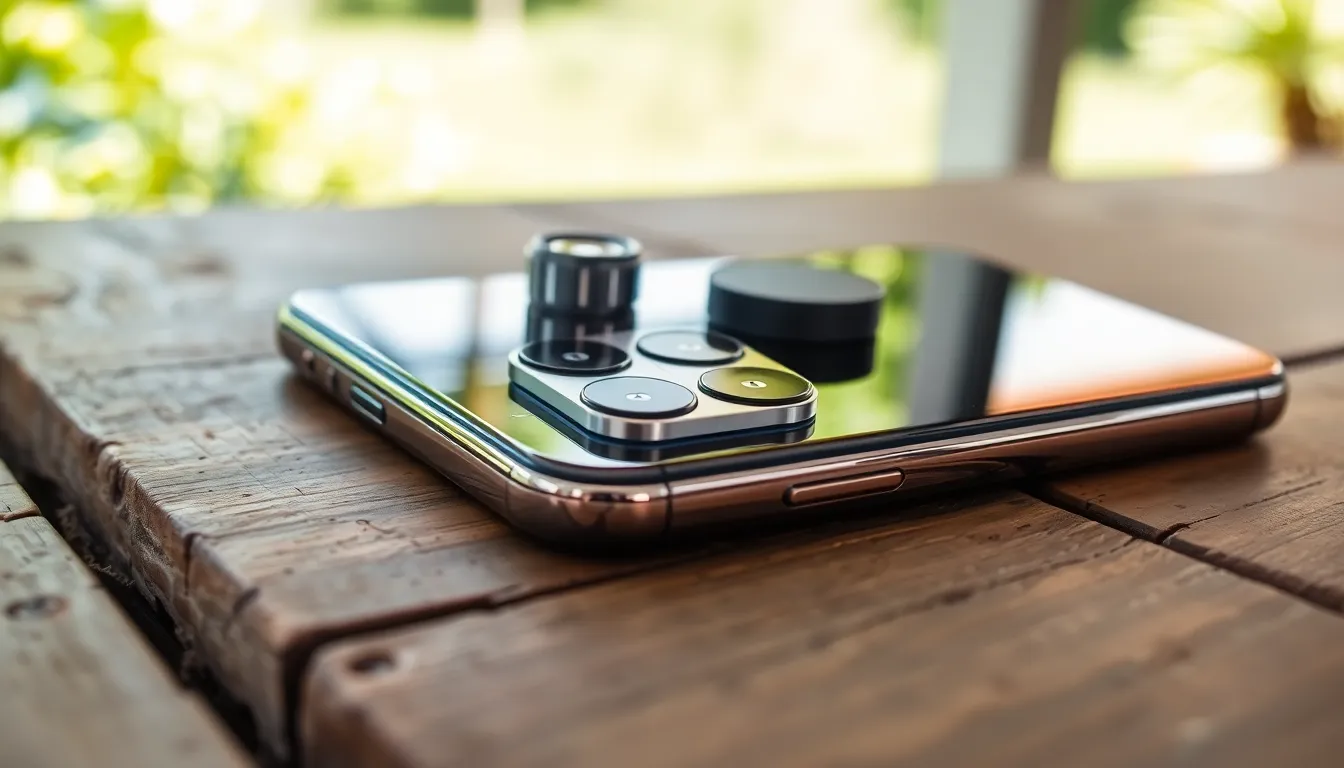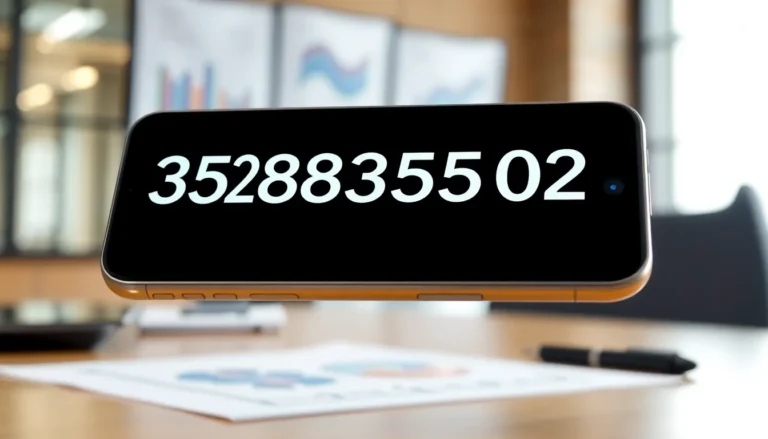In a world where everyone’s a photographer, it’s time to put those camera phones to the test. Gone are the days of lugging around heavy gear; now, the best shots are just a click away in your pocket. But with so many options out there, how do you choose the one that’ll make your Instagram feed pop and your friends envious?
Table of Contents
ToggleOverview of Camera Phones
Camera phones represent a significant advancement in mobile technology. Created to deliver professional-quality photography, these devices come equipped with features traditionally found in standalone cameras. Modern camera phones integrate high-resolution sensors, advanced image processing, and multiple lenses, allowing for versatility in various photographic settings.
Most devices boast features like optical image stabilization, night mode capabilities, and smart HDR. These functionalities enhance the quality of photos taken in different lighting conditions. On average, camera phones now use sensors exceeding 108 megapixels, resulting in sharp, detailed images suitable for sharing on social media platforms.
Manufacturers continuously innovate camera technology. For instance, computational photography techniques improve image quality beyond the hardware limits. Many devices incorporate features like portrait mode and background blurring to create stunning photographic effects.
Additionally, user experience plays a crucial role in camera phone selection. Factors such as camera app interface, processing speed, and ease of access to settings significantly influence a photographer’s ability to capture great images. Consumers often prioritize user-friendly apps alongside camera hardware specifications when making purchasing decisions.
Battery life remains a critical consideration for those who frequently use camera phones. Many smartphones now include fast-charging technology and energy-efficient components, minimizing downtime and ensuring photographers can shoot continuously.
The variety of camera phones available means every user finds options that suit their requirements. From professional photographers to casual users, there’s a camera phone designed for every skill level and artistic vision, delivering powerful image capture tools in a pocket-sized device.
Key Features to Look For

Choosing a camera phone involves examining specific features that significantly impact photo quality and user experience.
Camera Specifications
Camera specifications play a vital role in determining the overall performance of a camera phone. High-resolution sensors capture more detail, contributing to clearer images. Multiple lenses offer versatility, allowing users to switch between wide, ultra-wide, and telephoto perspectives for different shooting scenarios. Optical image stabilization reduces blurriness during handheld shots, particularly in low-light conditions. Night mode enhances low-light photography, making darker scenes look vivid and bright. Additionally, smart HDR optimizes high-contrast situations, ensuring balanced exposures across highlights and shadows.
Build Quality and Design
Build quality and design affect the usability and durability of a camera phone. Premium materials, such as glass and metal, promote resilience and an upscale feel. A compact, lightweight design facilitates easier handling during photography sessions. Ergonomically placed buttons enhance functionality, making it simple to adjust settings without fumbling. Weather resistance adds extra protection against rain or splashes, ensuring reliable performance in various environments. Finally, an intuitive camera app interface encourages seamless navigation, providing quick access to essential functions and enhancing the overall user experience.
Performance Evaluation
Camera phones excel in delivering exceptional performance, blending convenience with advanced technology to produce stunning results.
Image Quality
High-resolution sensors have transformed image quality significantly. Most modern camera phones feature sensors ranging from 12 MP to 108 MP, capturing intricate details with clarity. Users notice vivid colors and sharpness in images, thanks to improved image processing algorithms. Optical image stabilization further reduces blurriness, enhancing overall photo quality. Smart HDR often balances highlights and shadows effectively, making photos visually appealing. Many users appreciate versatile lens options, allowing for unique compositions.
Low Light Performance
Low light performance has become a critical aspect of camera phone capabilities. Devices incorporating night mode utilize longer exposure times and advanced algorithms to brighten dark scenes. Photographers see reduced noise and enhanced details in low-lit environments. Several camera phones now come equipped with larger apertures, which allow more light for clearer images. Users often welcome the integration of computational photography techniques, drastically improving low light results. Comparison tests consistently reveal that devices with dedicated night modes outperform those without this feature in dim conditions.
Video Capabilities
Video capabilities in camera phones now rival those of dedicated camcorders. Most newer models support 4K video recording, providing crisp and detailed footage. Users enjoy features like optical image stabilization and advanced autofocus for smoother video playback. Slow-motion video has become popular, with many devices offering frame rates of up to 240 fps. Enhanced audio recording features, such as stereo microphones, allow for high-quality sound to accompany visual content. Many vloggers and content creators rely on these features, making camera phones a preferred choice for versatile video production.
Comparing Top Camera Phones
Comparing top camera phones provides valuable insights for consumers looking to make informed choices. Analysis of major brands reveals unique features and benefits.
Brand A vs. Brand B
Brand A offers impressive low light performance with a night mode that significantly enhances image clarity. Optical image stabilization in Brand A’s models ensures steady shots even in challenging conditions. In contrast, Brand B excels in video capabilities, featuring 4K recording that appeals to content creators. Users appreciate Brand B’s camera app for its user-friendly interface, making it easy to navigate settings quickly. Each brand’s focus on different strengths allows photographers to select devices tailored to their specific needs.
Brand C vs. Brand D
Brand C showcases high-resolution sensors, ranging up to 108 MP, delivering stunning details in photographs. Night photography gains an advantage with larger apertures, capturing rich colors in dim environments. Meanwhile, Brand D emphasizes versatility with multiple lenses, allowing users to switch effortlessly between wide and telephoto perspectives. Enhanced audio recording during video captures makes Brand D a favorite among vloggers. Both brands present compelling options, catering to distinct preferences in the camera phone market.
User Experience and Feedback
User feedback indicates satisfaction with the camera app interface, which many find intuitive and easy to navigate. Customers appreciate features like quick access to shooting modes and settings, allowing for seamless photography experiences. The responsiveness of the camera to commands often plays a crucial role in user enjoyment, particularly in fast-paced environments.
Battery life is another notable factor affecting user experiences. Long-lasting battery duration ensures users can capture moments throughout the day without interruptions. Users commonly express frustration when battery drains quickly, particularly during extensive photo sessions or video recording.
Processing speed also garners attention, as delays can hinder the overall experience. Users report that swift processing times enhance their ability to capture images without missing critical moments. Advanced technologies, such as artificial intelligence, simplify adjustments, allowing users to focus on composition rather than technical settings.
Low light performance consistently draws positive remarks. Many users find that night mode enhances clarity, producing stunning images in dim conditions. Reviews frequently mention the ability to snap clear photos where older devices would struggle.
Video recording capabilities also receive excellent feedback. High-resolution 4K video and optical image stabilization contribute to a professional feel in vlogs and content creation. Users often highlight the importance of audio quality, deeming enhanced recording features a significant asset.
Overall, user experiences reflect a blend of innovation and practicality in modern camera phones. As smartphones evolve, the emphasis on user-centric design paired with advanced features continues to elevate photography standards. Users expect devices that not only capture high-quality images but also cater to their unique photography needs.
Choosing the right camera phone has never been more crucial for photography enthusiasts and social media users alike. With advancements in technology and features that rival traditional cameras, users can capture stunning images and videos effortlessly.
The importance of understanding specific needs and preferences cannot be overstated. Whether it’s low light performance or video capabilities, each brand offers unique strengths tailored to different styles of photography.
As consumers navigate through a sea of options, prioritizing usability and performance will ensure they select a device that enhances their photography experience. With the right camera phone in hand, capturing life’s moments in high quality becomes a seamless and enjoyable endeavor.





